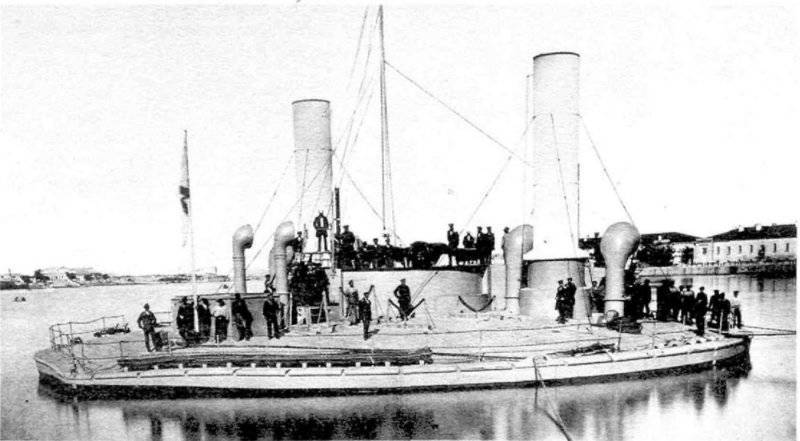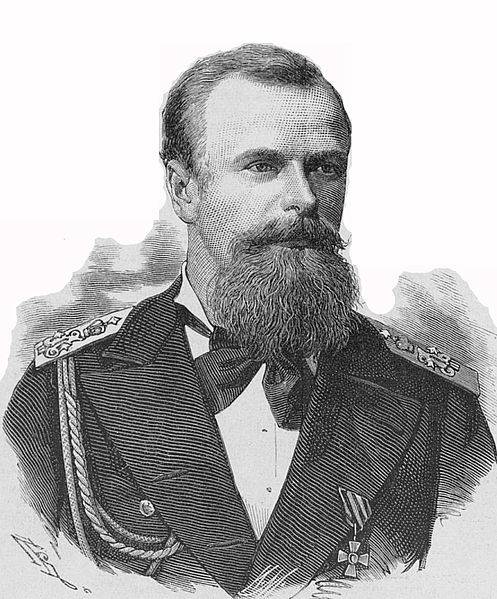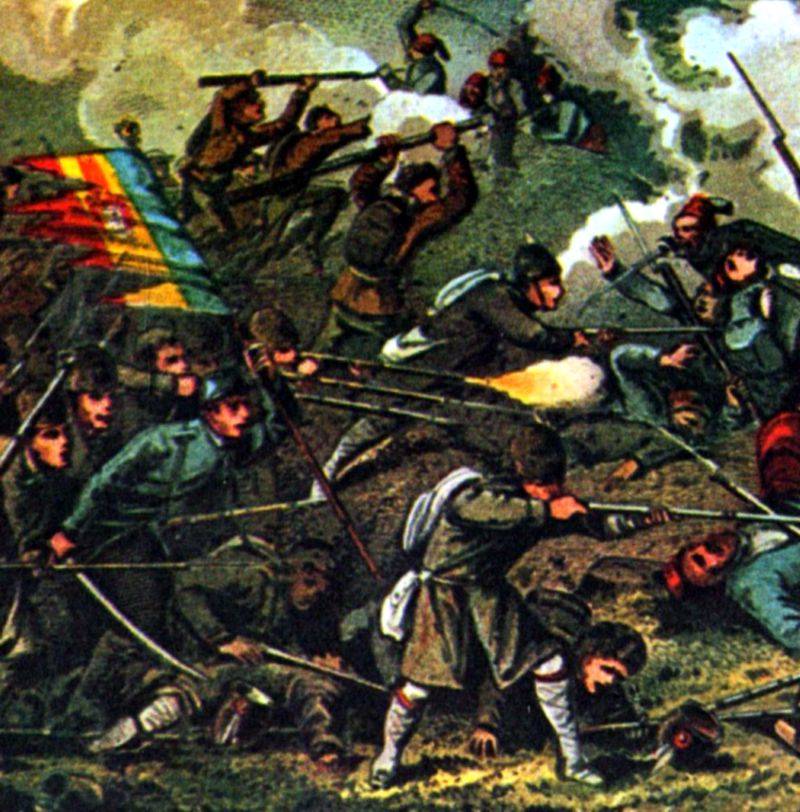Russian Black Sea Fleet on the eve of the war with Turkey
By 1876, Russia on the Black Sea had extremely weak naval forces. Altogether as part of the Russian Black Sea Naval fleet there were 39 ships, but among them there was not a single modern warship. As a result, the fleet could provide only minor assistance to the ground forces.
The most powerful ships were 2 armored floating batteries, the so-called. "Popovki". These were large flat-bottomed armored steam vessels designed by Vice Admiral A. A. Popov and engineer A. V. Mordvinov. The first ship, the Novgorod, was a ship with a displacement of 2491 t with a speed of 7 knots; carried on his 11 guns caliber 11 dm, eleven 4-pounder guns, 11 rapid-fire guns; had armor: side - 11 dm and deck - 3 dm. The second, "Vice Admiral Popov", a displacement of 3500 t with a speed of X numx knots; carried on itself eleven 8-dm guns, six 12-pounder guns, 4 rapid-fire cannons; had armor: side - 11 dm, deck - 15 dm. However, both of these vessels were designed for coastal defense and, due to their slow speed and design features, could not fight the enemy fleet on the high seas.
There were also 4 screw wooden corvette, 7 armed steamers, 13 screw schooners and the yacht "Livadia". On the eve of the war, 12 steamboats purchased from the Russian Society of Shipping and Commerce and mineboats were added to these ships. However, these ships were not full-fledged combat units, as they did not have armor, were poorly armed, and even then not all were outdated, small, or only of secondary importance.

Coastal battleship "Vice Admiral Popov"
The weakness of the Russian Black Sea Fleet, which had not long been a formidable naval force and glorified Russia with brilliant victories, was due to two main reasons. First, after defeat in the Crimean War, under the terms of the Paris Peace Treaty of 1856, Russia demilitarized its Black Sea coast. In particular, Russia did not have the right to maintain a navy in the Black Sea. In the 1870, these unfavorable conditions for the Russian Empire of the Paris Treaty were canceled, St. Petersburg took advantage of the defeat of the Prussians of France. That is, Russia had little time to create a full-fledged fleet on the Black Sea in peacetime conditions, without emergency measures.
Secondly, this is a false opinion of the Russian naval command about the uselessness of having a full-fledged fleet on the Black Sea. With political will and the mobilization of available resources over the next six years, the Black Sea Navy could be largely reconstructed. However, the main naval command believed that since Russia is not a leading maritime power, the Black Sea Fleet for her is a great luxury that you can afford only with an obvious surplus of funds. As we see, similar views still exist in Russia. They say, why does Russia need a large ocean fleet, we are a land power, and we will manage with cheap “mosquito fleet”. Therefore, the Black Sea coast defense was decided to build on the basis of ground forces, and the navy was going to be used only in coastal defense, and that was very limited.
However, the combat training of the personnel of the Russian Black Sea Navy, as well as other Russian fleets, was still at a high level. To a large extent this should be attributed to the merits of an active participant in the defense of Sevastopol, Admiral G. I. Butakova. After the end of the Crimean War, he was command of training squadrons of screw ships, was the chief commander of military ports in Nikolaev and St. Petersburg. Butakov focused on the combat training of crews and command personnel, the development of new techniques and tactical use of steam ships. In 1863, his book New Foundations of Steamship Tactics was published. She was awarded the Demidov Prize and translated into many foreign languages. Butakov was not only the founder of the new Russian tactics of the steam fleet, but also a tutor of Russian sailors in the spirit of the former glorious Russian naval traditions applied to the new conditions of the steam fleet. The associate of V. A. Kornilov, P. S. Nakhimov, and V. I. Istomin, Butakov was distinguished by his intelligence, courage, and large organizational skills. Butakov paid great attention to maneuvering in combat, artillery and mine training of personnel; he encouraged prudent risk and initiative among subordinates. Butakov widely practiced teachings in conditions close to the fighting.
Tactical and military educational ideas of Butakov led to the emergence of a whole school, which received wide recognition in Russian naval circles. The disciple and disciple Butakova was later known naval commander Makarov. Thus, if the Russian Black Sea navy was very weak in terms of the quantity and quality of the vessels, it was at a high level in the sense of combat training and cohesion of the personnel.
This was proven by the actions of the outstanding Russian naval commander Stepan Osipovich Makarov, a scientist. Before the war, he became the founder of the theory of the flooding of ships. He proposed to divide the ship into watertight compartments, install a pipeline on the ship with powerful pumps for pumping water from each compartment. And for sealing holes in the hull of the ship to use a special adhesive that can for some time reduce the flow. In 1876, Makarov was transferred to the Black Sea Fleet. During the war with Turkey, he suggested using small mineboats delivered to the operation site (enemy naval bases) on a high-speed steamer. The steamer "Grand Duke Konstantin" under the command of S. O. Makarov made a series of bold raids to Turkish bases, where the crews of the mine boats Navarin, Chesma, Sinop and Miner attacked the enemy with Whitehead torpedoes. Active use of mine and torpedo weapons showed that small combat boats can pose a serious threat even to large armored ships. Since that time, the era of active use of the light forces of the fleet began - mineboats, destroyers, and then for destroyers and torpedo boats.
The Baltic Fleet was a major force: 27 armored, 26 non-armored and 2 sailing ship. But due to the strategic disunity of the theaters, all these ships were to be sent for the upcoming hostilities, or even though some of the forces could not go to the Black Sea. Thus, the Black Sea Fleet could not organize a strategic operation, in particular, to seize the Bosphorus and Constantinople, and to land assault forces on the Caucasian or Balkan coast, supporting them with naval artillery fire.

Captain 2 rank Stepan Osipovich Makarov. 1877
Allied troops of Russia
Allies of Russia in the war against the Ottoman Empire were Romania, Serbia and Montenegro. The army of Romania by October 1876 of the year consisted of permanent and territorial troops with their reserve, police, national guard and militia. Standing army consisted of eight infantry regiments of the line dvuhbatalonnogo composition (four companies each), four battalions of rangers (arrows), two chetyreheskadronnyh hussar regiments, three squadrons of Calarasi, four regiments of artillery shestibatareynogo ended 6 guns in battery, an engineer battalion (four companies ), sanitary and economic transport.
Total Romania could put 20-th. permanent and 32-th. territorial troops with 144 guns. By the organization of wartime Romania exhibited two corps. Each of them consisted of two infantry divisions, a corps artillery regiment (36 guns) and a cavalry regiment. The infantry division consisted of two infantry brigades, a cavalry brigade and three artillery batteries; in the infantry brigade there were six battalions, in the cavalry - twelve squadrons.
The infantry of the permanent troops was armed with Henry-Martini rifles, and the infantry of the territorial army — partly with Dreyze’s guns, and partly with Krnka. The cavalry was armed with sabers, pistols, and partly with needle carbines. The artillery consisted of Krupp steel 4- and 9-pound guns; the latter are for the most part increased range (up to 8 km). In addition, in stock and in service consisted 40 rifled, loaded from the treasury, and 100 rifled, loaded from the barrel, guns.
The combat training of the Romanian army was carried out on the basis of Russian regulations. The exception was the infantry charter, which was borrowed from Belgium in 1869 year. The Romanian army had poor training. The Romanian army was young and did not yet have sufficient combat experience and strong military traditions. True, it was covered with enthusiasm, since the defeat of Turkey in the war would have brought Romania the final liberation from all dependence, and powerful Russia came out against the Ottoman Empire. The Romanian officer corps was the weakest; the noble officers were good at entertaining and feasting, and military training was unsatisfactory.
Serbia. The Serbian army consisted of a brigade of permanent troops numbering 4 thousand people ("standing army") and the home guard. The brigade of the permanent troops actually served as a kind of educational institution for the training of officers and non-commissioned officers.
The people's militia army was divided into two classes and was completed from six districts, which were divided into 18 brigade and 80 battalion sites. The counties exhibited 160 battalions, 33 squadrons and 18 six-gun batteries. The size of the army in wartime reached 153 thousand people. In fact, Serbia could not expose and arm more than 90-100 thousand people. The troops of the people's army of the first class were armed with Henry-Martini rifles, the second class - with Green rifles loaded from the barrel and treasury.
However, the war 1877-1878. the Serbian army was already defeated during the unsuccessful war with the Ottoman Empire (the Serbo-Turkish war of 1876-1877) and in the near future did not constitute a serious fighting force. In December, the 1876 of the year, its field troops, along with volunteers, totaled just 9 thousand people. For the restoration of the Serbian army, military material assistance to Russia was necessary (weapons, ammunition, ammunition, etc.).
Montenegro. The Montenegrin army was formed according to the old principle of the universal conscription in the event of war of the entire male population from the age of 14-16 to 60 years. The Montenegrin people could, with the greatest exertion of forces, expose up to 26 thousands of fighters with 20 mountain tools. Troops were reduced to companies (fours) and battalions armed with Austrian and captured Turkish rifles.
Thanks to the geographical features of the country (mountains) and the good fighting qualities of the fighters, the Montenegrin army, together with the Serbian forces, could chain itself to quite significant Turkish forces. But they were not capable of broad offensive actions at a considerable distance from their territory. Montenegro, together with Serbia, has already entered the war with Turkey and in 1877, the Montenegrins fought hard on the border with Herzegovina and Albania.
Thus, in the 1877-1878 war. the Romanian army could render the greatest assistance to the Russian troops. Romania was friendly to Russia and could become a strategic base for an attack on the Balkan theater. 4 (16) April 1877. Romania and the Russian Empire signed an agreement in Bucharest, according to which Russian troops are allowed to pass through the territory of Romania, with the condition that Russia does not dispute the integrity of Romania. Romania mobilized and troops were concentrated in the south of the country to defend against a possible attack by Ottoman forces from the south of the Danube. 12 (24) April 1877. Russia declared war on the Ottoman Empire, and its troops entered Romania through the newly built Eiffel Bridge in Ungheni (on the Prut River).

Romanian infantry in the battle of Pleven
Information